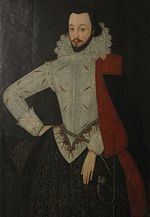Name Sir Bullock | Died 1644 | |
 | ||
Sir Edward Bullock of Faulkbourne (c. 1580 - 1644) was an English landowner, knighted by King James I and a Cavalier during the English Civil War. He purchased Faulkbourne Hall in 1637 which was held in the Bullock family for 260 years.
Contents
Family
Edward Bullock was born c. 1580, the elder son of Edward Bullock of Wigborough and Loftes in Great Totham and Joan Collen of High Laver, Essex.
Edward married Elizabeth, daughter and heir of Thomas Wylde of Glazeley Hall (died 1599), Salop and Kempsey, Worcester and sister of Sir Edmund Wylde. Edward died in 1644 and was buried at the Church of St Germanus at Faulkbourne. Edward and Elizabeth had one son, also Edward who married Mary, daughter of Sir William de Grey of Marton Hall Norfolk and his wife born Anne Calthorpe.
Early life
In 1602, he obtained from William Camden, the Clarenceux King of Arms, a "Confirmation" of the Arms of the Bullocks of Aborfield with due difference to mark his descent from a younger son.
On 3 July 1609 he was knighted by King James I at Richmond Palace.
From 1613 to 1618, he was Captain of Militia for the Maldon Hundred.
In the early days of the reign of King Charles I, he was appointed a Forced ‘Loan’ Collector for the County of Norfolk whilst living in Pentney, c. 1622-31. His accounts, which returned on 12 June 1627, show that as a result of his Commission, he paid the sum of £1,200 into the Royal Exchequer. The deeply unpopular loans hastened the rupture between the King and Parliament.
In 1630, Bullock sought to take land from his neighbours by force in Norfolk and, after his prosecution in 1633 before the Star Chamber, he was imprisoned in London.
He was free by 1635 and trying to live in London - perhaps in Clerkenwell where his widow lived after his death - when he became one of the many "divers Persons of Quality" prosecuted in the Star Chamber for "residing in Town contrary to the King’s Proclamation", having ignored the King's decree of 1632 to leave town and return to their country estates and local governmental duties.
King Charles had issued a proclamation in 1632 that the gentry should "depart from the cities of London and Westminster… and resort to the several counties where they usually resided". The intention of the proclamation was to ensure that nobility and gentry executed their local responsibilities. The unpopularity of this directive can be judged by the number of individuals who applied for "special dispensation licences" and the prosecutions in the Star Chamber for non-compliance.
Purchase of Faulkbourne
Edward resided at Loftes for much of his life until he purchased Faulkbourne.
In 1637, Sir Edward returned to Essex and bought the Manor and Estate of Faulkbourne which became the family home for 10 generations over 260 years.
The Manor had been held by Turbin in the time of Edward the Confessor and was given by William the Conqueror to his nephew Haimo whose niece passed the Manor by marriage to Henry I's natural son, Robert, Earl of Gloucester. It subsequently belonged to Richard de Luci, Lord Chief Justice of England and Sheriff of Essex in 1156. Passing through several hands, Sir Thomas Montgomery left the Manor to his nephew John Fortescue in 1494 whose descendant of the same name sold the Manor to Sir Edward.
The earliest parts of Faulkbourne Hall date from the 14th century, within the brick built Hall constructed in the 15th century. Substantial additions were made by Sir Edward in the 17th century, the remainder being a fine specimen of Early Tudor red brick. The exterior of the house holds a number of metalled vanes in the form of flags bearing the initials of the Bullock family.
The Church of St Germanus, which stands in the park, is Norman containing many memorials to the Bullock family formerly including the helm and pennon-rest of Sir Edward which was stolen in 1969.
Civil War
As the Civil War approached, a William Poe petitioned Parliament in May 1642 as a distressed prisoner against an unjust sentence of the Star Chamber following a suit against him taken by Sir Edward. He argued that, although the Star Chamber had been abolished, Sir Edward had combined with the Warden of Fleet Prison to prevent his discharge. Poe offered his services to Parliament having previously been a commander in Ireland, where he had lost all his estates. Poe was discharged by Parliament and joined the Parliamentary Army as a Captain active in Suffolk and in Cromwell’s own regiment. He is reported in Essex which may explain why Sir Edward fell foul of the Parliamentarians as a result of Poe's connections with the Parliamentarians Although Sir Edward was not active in the War, the Bullock family was strongly Royalist as a result of which at the close of the Civil War, in 1644, he was fined £300 by the Parliamentary Commission. Owing to his death in the same year, the liability devolved onto his son to whom, after proceedings which lasted 9 years, two-thirds of the original fine were ultimately remitted.
Sir Edward’s public and social duties resulted in heavy expenditure so that on his death, outlying estates of Loftes, Little Mapelstead and Finchingfield amongst others were sold.
On her husband’s death, Lady Bullock went to live in Clerkenwell where on 22 March 1644, a party of soldiers attacked her house and robbed her of gold and jewelry.
